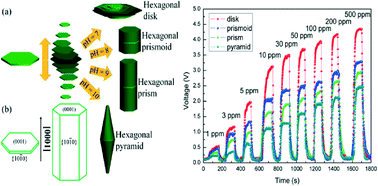Zinc oxide (ZnO) is an important semiconductor material which can be used for gas sensing. The sensing property relies on an oxidation-reduction reaction on the ZnO surface between the detected gas and surface oxygen molecules which causes the resistance of the sensor to change. The nature of exposed facets on the sensor is crucial to its performance however, control of the growth, number, and morphology of these features has so far proved difficult.
In their recent paper in CrystEngComm, Xiang, Xu and co-workers report a simple synthesis of ZnO which allows for exposed facet control. They discovered a two-step hydrothermal synthesis does not require use of any templates or surfactants but achieves structure control simply by adjusting pH. In this way, hexagonal-pyramids, -prisms, -prismoids and -disks could be formed (see below)/
The authors tested the materials for gaseous ethanol sensing and the sensitivity was found to vary in the order disks > prismoids > prisms > pyramids. They showed that the sensitivity of the sensors increased with exposure of (0001) crystal planes as these polar facets can provide more active sites for oxygen absorption than other facets, increasing the gas sensor response. Their new findings are significant for the future development of high performance gas sensors.
For more information, read the full paper:
Evolution of ZnO microstructures from hexagonal disk to prismoid, prism and pyramid and their crystal facet-dependent gas sensing properties
Nan Qin, Qun Xiang, Hongbin Zhao, Jincang Zhang and Jiaqiang Xu
CrystEngComm, 2014, DOI: 10.1039/C4CE00637B
__________________________________________________________________________________________________
 Gwenda Kyd has a PhD in metallocarborane chemistry from the University of Edinburgh. Other research work includes the spectroscopic study of the structure of glasses and organometallic electron-transfer reactions and the preparation of new inorganic phosphors. She has recently published a book on chemicals from plants.
Gwenda Kyd has a PhD in metallocarborane chemistry from the University of Edinburgh. Other research work includes the spectroscopic study of the structure of glasses and organometallic electron-transfer reactions and the preparation of new inorganic phosphors. She has recently published a book on chemicals from plants.











